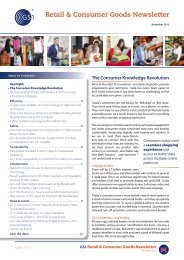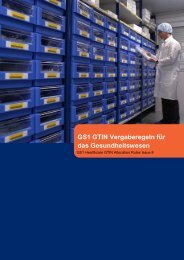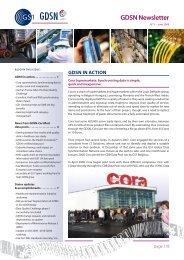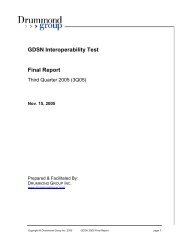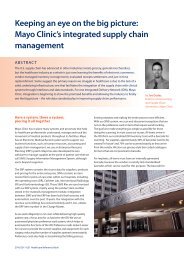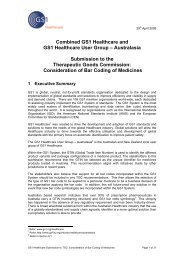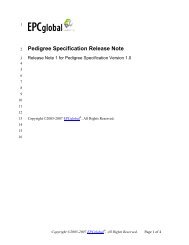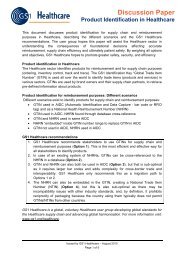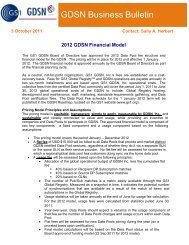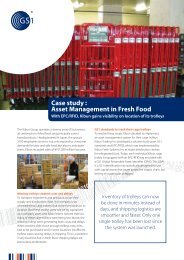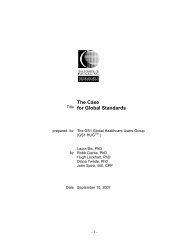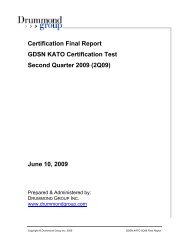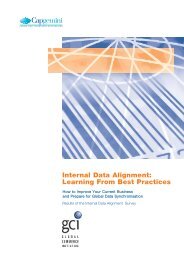The Application Level Events (ALE) Specification, Version 1.0 - GS1
The Application Level Events (ALE) Specification, Version 1.0 - GS1
The Application Level Events (ALE) Specification, Version 1.0 - GS1
Create successful ePaper yourself
Turn your PDF publications into a flip-book with our unique Google optimized e-Paper software.
1232<br />
1233<br />
1234<br />
1235<br />
1236<br />
1237<br />
1238<br />
1239<br />
1240<br />
1241<br />
1242<br />
1243<br />
1244<br />
1245<br />
1246<br />
1247<br />
1248<br />
1249<br />
1250<br />
1251<br />
1252<br />
1253<br />
1254<br />
1255<br />
1256<br />
1257<br />
1258<br />
1259<br />
1260<br />
1261<br />
1262<br />
1263<br />
1264<br />
1265<br />
1266<br />
1267<br />
1268<br />
1269<br />
1270<br />
1271<br />
1272<br />
1273<br />
a URN namespace identifier issued to the vendor by IANA, an OID URN whose<br />
initial path is a Private Enterprise Number assigned to the vendor, etc. Declarations<br />
of vendor-specific attributes SHALL specify use="optional".<br />
• Vendor-specific elements may be added to any type in which occurs. Vendor-specific elements SHALL NOT be in the EPCglobal <strong>ALE</strong><br />
namespace (urn:epcglobal:ale:xsd:1). Vendor-specific attributes SHALL<br />
be in a namespace whose namespace URI has the vendor as the owning authority (as<br />
described above). (In schema parlance, this means that all vendor-specific elements<br />
must have qualified as their form.)<br />
To create a schema that contains vendor extensions, replace the declaration with a content group reference to a group<br />
defined in the vendor namespace; e.g., . In the schema file defining elements for<br />
the vendor namespace, define a content group using a declaration of the following<br />
form:<br />
<br />
<br />
<br />
<br />
<br />
<br />
(In the foregoing illustrations, vendor and VendorExtension may be any<br />
strings the vendor chooses.)<br />
Explanation (non-normative): Because vendor-specific elements must be optional,<br />
including references to their definitions directly into the <strong>ALE</strong> schema would violate the<br />
XML Schema Unique Particle Attribution constraint, because the <br />
element in the <strong>ALE</strong> schema can also match vendor-specific elements. Moving the<br />
into the vendor’s schema avoids this problem, because ##other in<br />
that schema means “match an element that has a namespace other than the vendor’s<br />
namespace.” This does not conflict with standard elements, because the element form<br />
default for the standard <strong>ALE</strong> schema is unqualified, and hence the ##other in the<br />
vendor’s schema does not match standard <strong>ALE</strong> elements, either.<br />
<strong>The</strong> rules for adding attributes or elements to future versions of the EPCglobal standard<br />
schema are as follows:<br />
• Standard attributes may be added to any type in which <br />
occurs. Standard attributes SHALL NOT be in any namespace, and SHALL NOT<br />
conflict with any existing standard attribute name.<br />
Copyright © 2005, 2004 EPCglobal Inc, All Rights Reserved. Page 41 of 71



